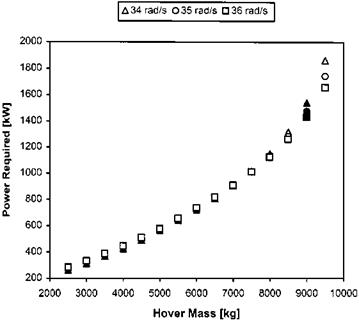Tip effects evaluation
Tip effects are a complex subject and determining their presence can be difficult and time-consuming. There are, however, advantages in proving that they are absent. If the effect of referred RRPM (m 1^0) on referred power (Plam*) can be ignored then there exists the possibility of generating a greater range of referred weight (Wlam2) through changes in RRPM. There is also the added benefit that when determining
mission suitability the effect of OAT on referred RRPM can be ignored. Although for simplicity this discussion is restricted to the free-air hover, tip effects should be investigated at high forward speed.
3.5.3.1 Source of tip effects
Before the process of investigating tip effects can be described in detail it is important to consider what is meant by the term. A tip effect is an actual increase in power arising from a change in rotor RPM that cannot be eliminated by referring the parameters using the W/am2 method. Consider the effect of a change in rotor speed on the power required to hover at a given weight. Assuming that power can be given by:
P = Tvih +1 pbc Q3r4cd
and that it is referred by dividing by p)3, which is directly proportional to am3, then:
P = К(-Ц) = k(—^ +1 bcRCD am3 Ip)3l ^p)3 8 d
Thus as the rotor speed is varied the contribution to referred power arising from profile power will be constant provided the average profile drag coefficient (CD) remains unchanged. If, on the other hand as a result of changes in RRPM, the blades ‘see’ different AOAs and Mach numbers which cause variations in CD then alterations in referred power will arise. Before ascribing changes in referred power, at constant weight, solely to tip effects it is necessary to consider the effect of RRPM on induced power. Recalling that the induced velocity in the hover is given by:
= [T =( W 1;2
Vih = ^ 2pA = 2pA J
Thus the contribution to referred power from induced power is:
TVh = T ( W i;2 = ГГ ( W V/2 p)3 p )3 ^2pA J у 2A yp)2 J
Therefore:
Thus in order to assess the size of any tip effect it is only necessary to document the variation of referred power (P/am3) with rotor speed at constant referred weight (W/am2). Since several test points may be established at differing altitudes it is necessary to use referred RRPM (m/^0) instead of rotor speed.
|
Fig. 3.18 Hover performance data – raw. |












